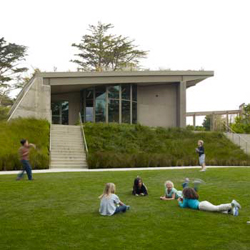Professional Practice
Children: Well-Being

The universal biophilic response adults have to the natural environment is especially pronounced in children. They feel the connection to -- and disconnection from -- the natural world more acutely than adults do. With less and less outdoor, unstructured playtime, children are increasingly disconnected from the natural world. This disconnection leads to fewer children who engage with nature and more that suffer from mental and physical issues that accompany a sedentary lifestyle.
How Nature Helps
A study published in Children’s Environments found that the proximity of green space to a child’s home had a major impact that the child’s health and well-being. Children without access to green space suffer significant setbacks in social and motor development.
Spending time outside encourages children to play, explore, and learn. A study published in the journal Environment and Behavior found that encouraging and supporting outdoor activities in children turns them into adults that continue the behavior of spending time outdoors. As with adults, spending time in nature instills our children with a positive sense of mental well-being and respect for the natural world.
Research
"The Influence of Childhood Operational Pathways on Adult Nature-Based Activities," Environment & Behavior, 2012
“Making Friends In Zurich's Urban Forests And Parks: The Role Of Public Green Space For Social Inclusion Of Youths From Different Cultures,” Forest Policy and Economics, 2009
”Cute and Cuddly and a Whole Lot More? A Call for Empirical Investigation into the Therapeutic Benefits of Human-Animal Interaction for Children,” Behaviour Change, 2001
“Views of Nature and Self-Discipline: Evidence From Inner City Children,” Journal of Environmental Psychology, 2001
“Growing Up in the Inner City: Green Spaces as Places to Grow,” Environment and Behavior, 1998
“Children And Their Living Surroundings: Empirical Investigations Into The Significance Of Living Surroundings For The Everyday Life And Development Of Children,” Children’s Environments, 1995
 ASLA 2010 Professional General Design Honor Award, Nueva School, Hillsborough, California, Andrea Cochran Landscape Architecture / Image credit: Marion Brenmer
ASLA 2010 Professional General Design Honor Award, Nueva School, Hillsborough, California, Andrea Cochran Landscape Architecture / Image credit: Marion Brenmer
Resources
The Health Benefits of Parks , The Trust for Public Land
Health Benefits, National Wildlife Organization
US Fish and Wildlife Service
Organizations
E.O. Wilson Center
Outdoor Nation
National Environmental Education Foundation
The Student Conservation Association
Role of the Landscape Architect
By designing schools whose grounds are integrated into the surrounding landscapes, as well as spaces for outside learning and unstructured play, landscape architects provide children with access to nature in their day to day lives.
Designed naturalistic parks in the heart of cities, like Dumbarton Oaks Park, in Washington DC, allow children the chance to run, play and discover nature, all while being near home.
Case Studies
Nueva School, Hillsborough, California, Andrea Cochran Landscape Architecture
Dumbarton Oaks Park, Washington, D.C., Beatrix Farrand, ALSA
<< Type II Diabetes
Home >>